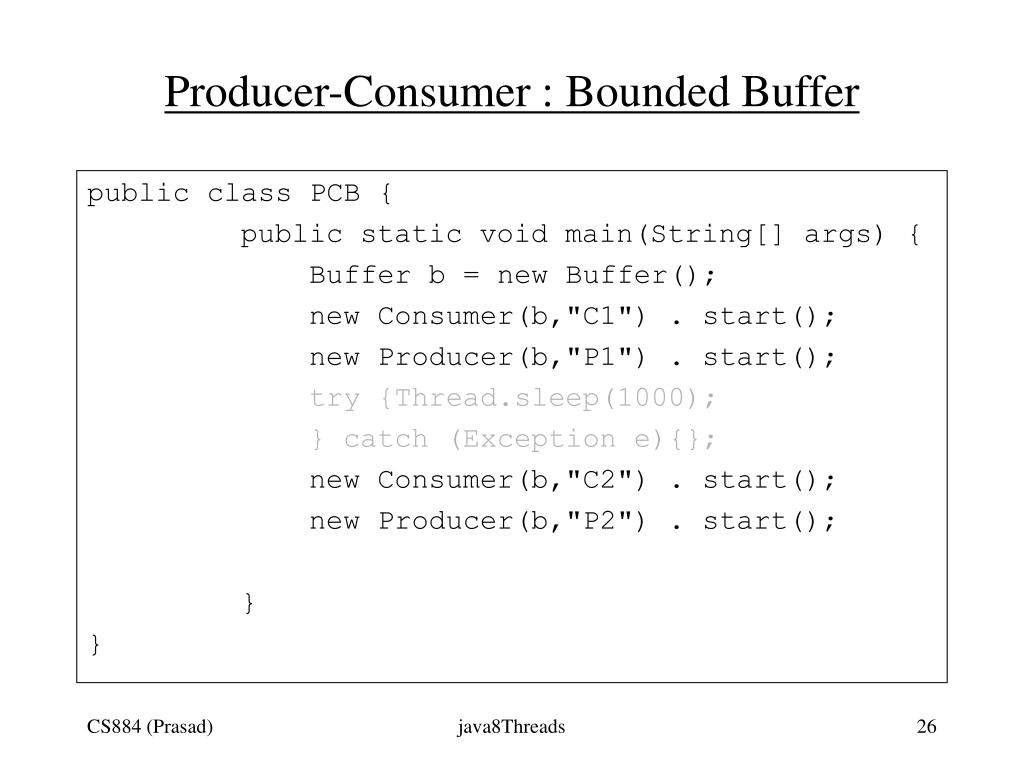
A producer will signal this semaphore after writing to the buffer.Ī new bounded buffer with 10 elements will be represented as follows.Įmpty slots in the buffer and is initialized to 10. A consumer must wait on this semaphore before reading from the buffer. Use one semaphore named data to count the number of data items in the buffer. A consumer will signal this semaphore after reading from the buffer. A producer must wait on this semaphore before writing to the buffer. Use one semaphore named empty to count the empty slots in the buffer. Two counting semaphores can be used for this. Consumers must block if the buffer isĮmpty. Producers must block if the buffer is full.  A consumer reading from a buffer slot and updating out.Ī binary semaphore can be used to protect access to the critical sections. A producer writing to a buffer slot and updating in. Specifically, mutual exclusion must be enforced between the following critical Critical sections and mutual exclusionĪll updates to the buffer state must be done in a critical section. This semaphore will be used to block producers if the buffer is full. psem_t *empty A counting semaphore used to count the number of empty slots in the buffer. Semaphore will be used to block consumers if the buffer is empty. psem_t *data A counting semaphore used to count the number of items in the buffer. psem_t *mutex A binary semaphore used to enforce mutual exclusive updates to the buffer. int in The index in the array from where the next item should be consumed. int out The index in the array where the next items should be produced. int size The number of elements in the array, i.e., the size of the buffer. tuple_t *array This pointer will point to a dynamically allocated array of buffer items of The purpose of the struct members are described below. A tuple is represented by the following C struct. The buffer will store tuples (pairs) with two integerĮlements a and b. To implement the bounded buffer you will use two C structures You will us the psem semaphores to synchronize the bounded buffer.
A consumer reading from a buffer slot and updating out.Ī binary semaphore can be used to protect access to the critical sections. A producer writing to a buffer slot and updating in. Specifically, mutual exclusion must be enforced between the following critical Critical sections and mutual exclusionĪll updates to the buffer state must be done in a critical section. This semaphore will be used to block producers if the buffer is full. psem_t *empty A counting semaphore used to count the number of empty slots in the buffer. Semaphore will be used to block consumers if the buffer is empty. psem_t *data A counting semaphore used to count the number of items in the buffer. psem_t *mutex A binary semaphore used to enforce mutual exclusive updates to the buffer. int in The index in the array from where the next item should be consumed. int out The index in the array where the next items should be produced. int size The number of elements in the array, i.e., the size of the buffer. tuple_t *array This pointer will point to a dynamically allocated array of buffer items of The purpose of the struct members are described below. A tuple is represented by the following C struct. The buffer will store tuples (pairs) with two integerĮlements a and b. To implement the bounded buffer you will use two C structures You will us the psem semaphores to synchronize the bounded buffer. 
Most likely you will be able to use any resonable modern version of
#Producer consumer with bounded buffer binary semaphor code
The provided code has been developed and tested on the department Linux systemĪnd macOS. Test the implementaion for different sizes of the buffer and different numbers Here you can add your ownīounded_buffer_stress_test.c The module-4/mandatory/src/bounded_buffer_test.c program make it easy to Module-4/mandatory/src/bounded_buffer_test.c file. bounded_buffer_test.c To test your various aspect of your implementation a collection of tests are provided in the Module-4/mandatory/src/bounded_buffer.c file. bounded_buffer.c The implementation of the API will be in the bounded_buffer.h The internal representation of the bounded buffer and the public API isĭefined in module-4/mandatory/src/bounded_buffer.h. TheseĪre the files you will use to implement and test your implementation. You will implement the bounded buffer as an abstract datatype. Two or more consumers reads the same slot.A consumer attempts to consume a slot that is only half-filled by a producer.A Consumer consumes an empty slot in the buffer.The consumers doesn’t block when the buffer is emtpy.Two or more producers writes into the same slot.The producers doesn’t block when the buffer is full.Proper synchronization the following errors may occur.

To store the data items inside the bounded buffer are called slots. SynchronizationĪ bounded buffer with capacity N has can store N data items.

Before you continue, make sure to read the self study
Consumers must block if the buffer is empty.Īmong the slides you find self study material about classic. Producers must block if the buffer is full. To the buffer and consumers read data from the buffer. Multiple producers and multiple consumers share a single buffer. The bounded-buffer problems (aka the producer-consumer problem) is a classicĮxample of concurrent access to a shared resource. 4 - Threads, synchronization and deadlockĥ - Memory management, files and file systems








 0 kommentar(er)
0 kommentar(er)
